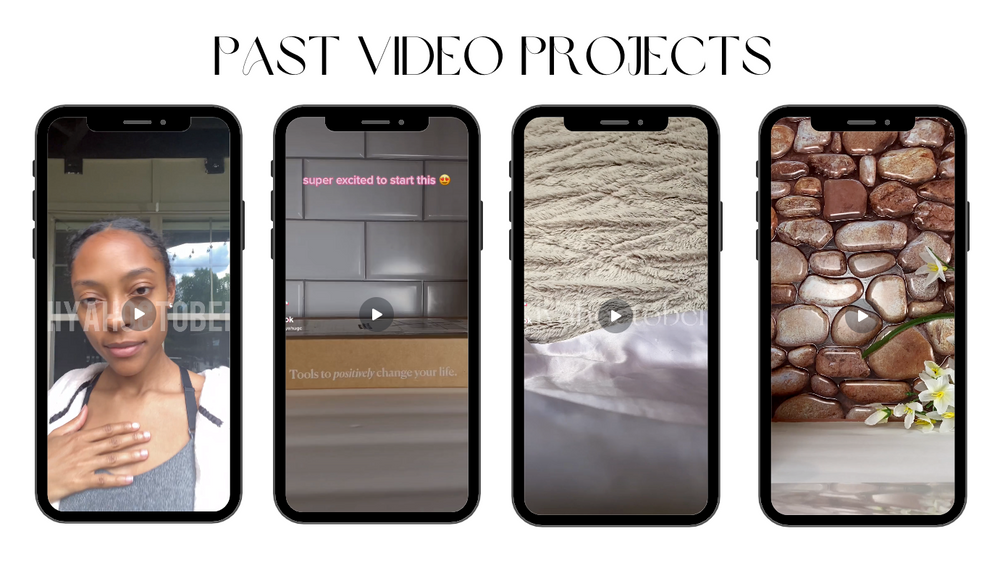How To Become a UGC Creator (with no experience!)
Are you a content creator looking to explore new opportunities and elevate your online presence? In the ever-evolving world of content creation, one of the most exciting and promising avenues is User-Generated Content (UGC) creation. UGC creators play a pivotal role in promoting products, services, and businesses by leveraging the authenticity of real people. The best part? You don’t have to have a certain amount of followers – ANYONE can be a paid UGC creator if they have a smartphone and some skills. The main difference between UGC creators and influencers is that UGC creators create and deliver to businesses without the obligation to post it on their channels. Let’s dive into some tips and strategies on how to become a UGC creator!

How To Become a UGC Creator
User-generated content (UGC) is the buzzword in today’s digital landscape. Brands are increasingly realizing the immense value of content created by their own users, customers, and fans. UGC takes the form of posts, reviews, videos, and more, typically created and shared by customers who genuinely love a brand’s products or services.
So, what exactly is UGC, and why is it so valuable?

What Is A UGC Creator?
A UGC creator, which stands for User-Generated Content creator, simply put is a creator who generates content for brands. UGC creators inject authenticity and relatability into promotional content, making it highly effective in connecting with audiences.
UGC, or User-Generated Content, refers to any content, such as text, images, videos, or reviews, that is created by users of a brand, product, or service. Unlike traditional marketing content produced by internal marketing teams, UGC is contact that is created by UGC creators to show organic and authentic reviews. Examples of UGC include Instagram posts featuring a brand’s product, tweets raving about a great customer experience, and YouTube videos showcasing product demonstrations.
Brands often source UGC by identifying existing customers who are already talking about them online. When a brand reposts a creator’s Reel or shares a screenshot of someone’s Tweet, that’s a prime example of UGC in action.
But what makes UGC so valuable from a brand’s perspective?
- UGC creators are believed to be better at creating content that resonates with an audience than everyday marketers or influencers due to their ability to tap into authentic experiences and genuine interactions.
- It is user-generated content—meaning it is made by the user for the user—which often results in content that is more relatable, trustworthy, and engaging for the target audience.
- Creating content that resonates could encompass various strategies, such as crafting relatable narratives, sharing authentic experiences, or producing shareable content that sparks conversations and connections among users.
Why Is User-Generated Content Valuable?
UGC holds immense value for brands because it provides social proof, a powerful psychological concept. Social proof is built on the idea that people tend to trust other people more than they trust brands. When brands share content created by real users (even if they are strangers on the internet), it adds credibility and authenticity to their marketing efforts.
Imagine scrolling through your social media feed and seeing posts from real people raving about a product or service. These are not scripted endorsements; they are genuine expressions of satisfaction and enthusiasm. Such content carries weight because it demonstrates that the brand has satisfied customers who not only use their products or services but also enjoy them enough to share their experiences online.
This emphasis on social proof is one of the reasons why UGC creation is a more accessible field to break into compared to social media influencing. As a UGC creator, you don’t necessarily need a massive following or a significant online presence because you’re not selling your personal influence. Instead, you’re creating content that adds value to brands.
So, how can you get started on your journey to becoming a UGC creator?
Steps To Become a UGC Creator
The beauty of UGC creation lies in its lower barriers to entry compared to influencer marketing. You don’t need an extensive follower count, and you don’t require advanced technical skills or specialized equipment. Here’s how you can kickstart your UGC creator journey:
Step 1: Perfect Your Filming Setup
Creating high-quality UGC content requires a well-equipped filming setup. Invest in a good camera or smartphone with excellent video capabilities, a tripod, lighting equipment, and a microphone if needed. A clean and professional setup will make your content stand out.
Step 2: Gather Your Equipment
Depending on your niche, you may need specific equipment or props. Collect all the tools, props, and accessories you’ll require for your UGC content creation. Ensure everything is in working order before you start filming.
Step 3: Practice Your Editing Skills
Editing plays a crucial role in UGC creation. Learn how to edit your videos to make them engaging and visually appealing. Familiarize yourself with video editing software like Adobe Premiere Pro or Final Cut Pro. There are also user-friendly apps available for beginners.
Step 4: Create Authentic Content
One of the hallmarks of a successful UGC creator is authenticity. Create content that feels genuine and relatable to your audience. Show yourself using the product or service in your daily life, sharing honest reviews, and telling your story. Authenticity builds trust with your audience.
Step 5: Create a UGC Creator Portfolio
Just like any creative profession, you’ll need a portfolio to showcase your work to potential clients and brands. Building a polished and professional portfolio is a significant milestone for aspiring UGC creators. Here are some templates that you can use and customize on Canva. Let’s go over what you should include in your UGC creator portfolio:

1. Introduction:
Start with a brief introduction about yourself. Include any relevant work history or content you’ve created for other brands.
2. Work Samples:
The heart of your portfolio should be the display of your work. Include photos and videos that highlight your ability to create the type of content that brands are seeking. Video content is especially crucial, as video is currently a dominant format in marketing. Demonstrate your proficiency in creating engaging videos.
3. Contact Information:
While you can conduct business outreach and communication through social media direct messages, it’s a best practice to provide a dedicated email address in your portfolio. This facilitates clear and straightforward communication with potential clients.

Creating your first portfolio may seem daunting, especially if you don’t have existing UGC work to showcase. Start by creating UGC content with items you already own. Here are some examples of UGC content you can create when you’re just starting out:
- Capture product photography and videos of aesthetic items from your personal collection.
- Film unboxing videos with natural, unscripted reactions.
- Create content that shows you using a product you genuinely love and provide a brief tutorial or review.
Remember, this content doesn’t need to be overly professional. Brands are often looking for content that resembles something created by an everyday user of their product. Simple smartphone photography and videography with good natural lighting is sufficient. You don’t need extensive editing skills, but using online video editing tools to combine clips and add captions can enhance your work.
Step 6: Find UGC Job Opportunities with Brands
Now that you have a portfolio, it’s time to start monetizing. There are several ways to catch the attention of brands in need of UGC:
- Cold Outreach: Reach out to brands you want to work with and share your UGC portfolio. Express your interest in collaborating and highlight how your content aligns with their values and target audience. Effective collaboration can lead to exciting opportunities and brand partnerships.
- Twitter : Some brands actively seek UGC creators by posting and searching on platforms like Twitter. Instead of you initiating contact, you can respond to a job posting. This approach ensures that the brand is actively looking for UGC creators, but it also means increased competition as other creators may be pitching their services simultaneously. (tip: when you follow other creators, you can see what brands they are working with and know that those are brands who work with UGC creators).
- Organic Discovery through Pinterest: Utilize Pinterest to showcase your portfolio work and leverage organic discovery. Create a dedicated UGC-specific Pinterest account and tag your pins with relevant keywords such as “UGC Content,” “UGC Creator,” or “UGC Example.”
Step 7: Create a UGC-Specific Account
When starting your UGC journey, I’d suggest you create a dedicated UGC-specific account. Make sure to include the term “UGC” in your account handle, so that you appear in search results when brands are looking for UGC creators. Try to
Once your account is set up, follow other UGC creators on platforms like TikTok and Twitter to immerse yourself in the UGC community. This is an excellent way to gain insights into the industry, establish contacts, and get a feel for the dynamics of UGC creation. Many UGC creators are generous in sharing their knowledge, templates, and best practices.
Common Mistakes to Avoid
As you embark on your journey as a UGC creator, it’s essential to be aware of common mistakes that can hinder your progress. These mistakes can be categorized into two phases: those you make before securing a brand deal (portfolio mistakes) and those you make after securing the deal (contract mistakes).
UGC Portfolio Mistakes
- Including Your Rates in Your Portfolio: While it may be tempting to include your UGC rates in your portfolio, it’s generally not recommended. When you list your rates, one of three scenarios may unfold: brands may perceive your rates as too expensive, too cheap, or just right. This limits your negotiating flexibility. Instead, convey that your rates are negotiable when brands inquire about your portfolio. Maintain a clear asking rate and a lower limit that you would accept, ensuring it aligns with your worth.
- Not Making the Content the Focus of Your Portfolio: Keep your portfolio simple and easy to navigate, with the focus squarely on your UGC content. Avoid clutter and excessive information. While some UGC creators include a “What Is UGC?” section to educate brands about its value, this is often unnecessary. Brands reviewing your portfolio likely already understand the significance of UGC.
UGC Contract Mistakes
- Not Negotiating Payment Properly: In your contracts, ensure that you negotiate payment terms effectively. Most creators request at least half of the payment upfront before commencing work, with the remainder due upon completion. Some opt for full payment upfront. Clearly outline payment terms to avoid misunderstandings.
- Not Watermarking Your Content Before Payment: Protect your work by adding watermarks to your content before payment. This precaution safeguards your creations until you receive payment. Watermarking can be as simple as overlaying a semi-transparent text bubble with your UGC handle, making it difficult to remove without your consent.
- Not Negotiating Usage Rights: In your contracts, specify the usage rights granted to brands. Indicate the duration for which the brand can use your content without additional compensation. For example, a common practice is to grant 30-day usage rights and charge a renewal fee for extended usage in ongoing ad campaigns.

PRO TIP: Seek contract templates from fellow creators or consult with someone knowledgeable in law to ensure your contracts are well-structured and protect your interests.
Promote Your Personal Brand

As a UGC creator, you’re not just promoting products; you’re also building your personal brand. Consistency is key. Maintain a cohesive style, posting schedule, and engage with your audience. Building a loyal following will make you an attractive partner for brands.
How To Find UGC Opportunities
There are many ways of finding brand partnerships, and while it takes effort, they are out there waiting to be discovered!
Utilize social media platforms to observe which brands are actively collaborating with other UGC creators, gaining insights into potential partnership opportunities. This is a great tool for finding brand partnernships.
1. Leveraging Social Media Platforms:
Twitter, in particular, serves as a vibrant hub for UGC creators and brands seeking collaboration. Many brands actively post job opportunities or search for UGC creators through hashtags like #UGCcreator or #UGCopportunity. By following brands in your niche and engaging with relevant hashtags, you can stay updated on potential UGC gigs. Additionally, joining Twitter conversations related to UGC creation can help you network with fellow creators and discover new opportunities.
2. Utilizing UGC-Centric Apps:
Apps like Cohley are specifically designed to connect brands with UGC creators. These platforms streamline the process of finding and applying for UGC opportunities by providing a centralized space for creators to browse available gigs, submit proposals, and showcase their portfolios. By creating a profile on such platforms and actively engaging with available opportunities, you can increase your chances of securing UGC projects.
3. Sending Personalized Pitches:
Another effective approach is to proactively reach out to brands with personalized pitches accompanied by your UGC portfolio.
Research brands that align with your content style and target audience, then craft compelling pitches highlighting how your content can add value to their marketing efforts. Include relevant samples from your portfolio to demonstrate your expertise and showcase your ability to create engaging UGC content.
By demonstrating a genuine interest in collaborating and providing tangible examples of your work, you can grab the attention of brands and secure UGC opportunities.
GRAB MY FREE EMAIL PITCH TEMPLATES HERE!
4. Networking and Collaboration:
Networking within the UGC creator community can also open doors to new opportunities. Engage with fellow creators on social media platforms, participate in UGC-focused forums or Facebook groups, and attend industry events or virtual meetups.
By building relationships with other creators, you may discover collaborative projects or receive referrals for UGC opportunities.
Additionally, collaborating with other creators on joint projects can expand your reach and visibility within the UGC community, making you more appealing to brands seeking collaborative partnerships.
5. Organic Discovery Through Pinterest:
Pinterest serves as a valuable platform for organic discovery and showcasing your UGC portfolio. Create a dedicated Pinterest board featuring your best UGC content, optimized with relevant keywords such as “UGC Content,” “UGC Creator,” or “UGC Examples.” By tagging your pins strategically and leveraging Pinterest’s search algorithm, you can increase the visibility of your portfolio and attract the attention of brands seeking UGC creators.
By leveraging these strategies, you can effectively navigate the UGC landscape, identify exciting opportunities, and establish yourself as a sought-after UGC creator. Whether through social media platforms, specialized apps, personalized pitches, networking, or organic discovery, there are numerous avenues to explore in your quest to find UGC opportunities and elevate your UGC creation journey.
UGC creators are in high demand because they bring authenticity and relatability to promotional content. By following these steps, you can embark on your journey to becoming a successful UGC creator and working with brands you admire. So, get started, create a UGC portfolio, and share your unique perspective with the world.
If you’re interested in expanding your influence further, check out our guide on how to become an Instagram influencer. A lot of brands tend to pay extra if you can provide both UGC content and a following to promote it to. This guide will help you navigate the world of social media and grow your presence as a content creator.
UGC creation is a rewarding path in the realm of content creation. As brands increasingly seek real people to promote their products and services, UGC creators are well-positioned to thrive. Build your skills, portfolio, and personal brand, and you’ll be on your way to becoming a successful UGC creator.






This is really interesting. I’ve seen videos about UGC online but I never really understood them until this post! Perfectly explained and is definitely something I will be looking into.